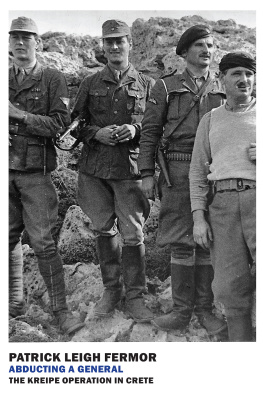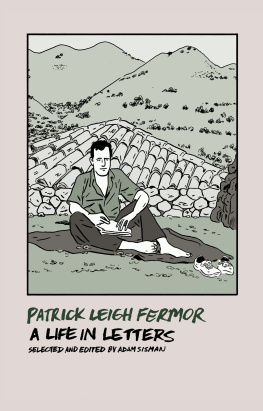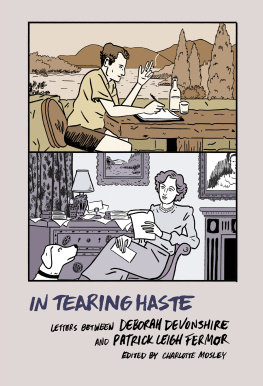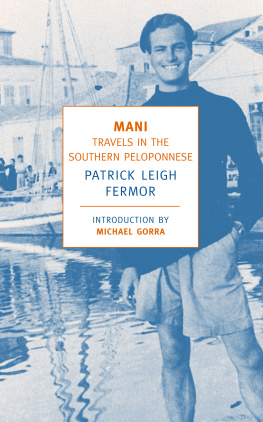Fermor Patrick Leigh - More Dashing: Further Letters of Patrick Leigh Fermor
Here you can read online Fermor Patrick Leigh - More Dashing: Further Letters of Patrick Leigh Fermor full text of the book (entire story) in english for free. Download pdf and epub, get meaning, cover and reviews about this ebook. City: London, year: 2018, publisher: Bloomsbury Publishing Plc, genre: Detective and thriller. Description of the work, (preface) as well as reviews are available. Best literature library LitArk.com created for fans of good reading and offers a wide selection of genres:
Romance novel
Science fiction
Adventure
Detective
Science
History
Home and family
Prose
Art
Politics
Computer
Non-fiction
Religion
Business
Children
Humor
Choose a favorite category and find really read worthwhile books. Enjoy immersion in the world of imagination, feel the emotions of the characters or learn something new for yourself, make an fascinating discovery.

- Book:More Dashing: Further Letters of Patrick Leigh Fermor
- Author:
- Publisher:Bloomsbury Publishing Plc
- Genre:
- Year:2018
- City:London
- Rating:5 / 5
- Favourites:Add to favourites
- Your mark:
- 100
- 1
- 2
- 3
- 4
- 5
More Dashing: Further Letters of Patrick Leigh Fermor: summary, description and annotation
We offer to read an annotation, description, summary or preface (depends on what the author of the book "More Dashing: Further Letters of Patrick Leigh Fermor" wrote himself). If you haven't found the necessary information about the book — write in the comments, we will try to find it.
More Dashing: Further Letters of Patrick Leigh Fermor — read online for free the complete book (whole text) full work
Below is the text of the book, divided by pages. System saving the place of the last page read, allows you to conveniently read the book "More Dashing: Further Letters of Patrick Leigh Fermor" online for free, without having to search again every time where you left off. Put a bookmark, and you can go to the page where you finished reading at any time.
Font size:
Interval:
Bookmark:

MORE DASHING
In memory of John Julius Norwich
19292018
ALSO BY PATRICK LEIGH FERMOR
The Travellers Tree (1950)
The Violins of Saint-Jacques (1953)
A Time to Keep Silence (1957)
Mani (1958)
Roumeli (1966)
A Time of Gifts (1977)
Between the Woods and the Water (1986)
Three Letters from the Andes (1991)
Words of Mercury (2003), edited by Artemis Cooper
In Tearing Haste (2008), edited by Charlotte Mosley
The Broken Road (2013), edited by Artemis Cooper and Colin Thubron
Abducting a General (2014)
(translated and edited)
The Cretan Runner (1955), by George Psychoundakis
ALSO BY ADAM SISMAN
A. J. P. Taylor (1994)
Boswells Presumptuous Task (2000)
The Friendship (2006)
Hugh Trevor-Roper (2010)
John le Carr (2015)
(edited)
One Hundred Letters from Hugh Trevor-Roper (2013), with Richard Davenport-Hines
Dashing for the Post (2016)

Contents
This is a second selection from the letters of Patrick Leigh Fermor, a successor to Dashing for the Post, published in 2016. The title, like that of its predecessor, alludes to an expression often used by Paddy (as he called himself, and as almost everyone called him), dashing for the post. His letters suggest that he is always writing in a rush. No more now, darling Diana, as I must pelt down the hill to the post, ends one typical letter to Lady Diana Cooper. Many of his letters are headed In Tearing Haste so many, in fact, that he felt able to use the phrase as the title for a volume of his correspondence with his intimate friend Debo, Duchess of Devonshire. This hurry appears to have been motivated by a sense of duty, or even guilt; his letters are peppered with requests for forgiveness for not having written earlier. After heading one letter In Sackcloth and Ashes, he continued: The above should be the title of a published volume of my letters if published one day in a hundred years time as all my letters start with abject apologies for lateness in answering In another he wrote that sackcloth and ashes were my letter-writing uniform. (The publishers of this volume felt that In Sackcloth and Ashes would be a misleading title for a collection of such exuberant letters.)
Yet if some of his letters were written at speed, most were written with care. They are full of wit and sparkle. Some of them are long, and must have taken hours to write indeed, some of the letters themselves show that he wrote them over a period of several days.
Letters mattered to Paddy for a number of reasons, both practical and personal. One was that he moved around a lot. He travelled widely throughout his long life, so letters were a means of informing his friends where he was and where to find him. When he did settle, it was in what was then a remote corner of the Peloponnese, where friends from England were unlikely to call unless invited to stay. Letters provided a lifeline from this isolated spot.
Paddy was a very sociable person who was often alone. Friends were important to him, and he kept his friendships in good repair by correspondence. Yet it went further than this. For him, letters were a means of reaching out to those whose company he enjoyed, of making convivial connections across the void. Paddy seems to relish the contact with those to whom he is writing, even if it is only on paper. He is psychologically and often emotionally engaged with his correspondent. He writes to give pleasure to the recipient. His prose is lively, sometimes effervescent. The warmth of his personality rises from the page. At times one senses that Paddy is writing to raise his own spirits, as if he knows that his imaginative construction of those of whom he is fond will bring him comfort and cheer.
Another reason why Paddy took so much trouble with his letters is his awareness that they might one day find their way into print. The letters themselves occasionally hint at this possibility I have already mentioned one such hint, his suggestion that any volume of his letters, if published in a hundred years time, should be entitled In Sackcloth and Ashes.
Dashing for the Post received enthusiastic, even ecstatic, reviews. It goes without saying that nobody writes letters like this anymore, and its a loss, wrote Charles McGrath, reviewing the book in the New York Times. Here are descriptions and anecdotes equal to anything in his writing, wrote Colin Thubron, himself one of the finest travel writers alive. John Julius Norwich likened Paddy to the great letter-writers of the past, among them Byron, Horace Walpole and Henry James.
When first asked to make a selection of Paddys letters, I had little notion of what I would find. I did of course know that he and Debo Devonshire had maintained a delightful correspondence over more than half a century, which had been collected and published in 2008, skilfully edited by Charlotte Mosley. But I did not know then that those letters were matched by others for example, his correspondence with Diana Cooper, from 1952 until her death in 1986. One could make an equally enjoyable book from their exchanges: arguably even more so, because Diana was a better writer than Debo. Paddys letters to her were just as entertaining, and there were so many first-rate ones that I found it necessary to ration them in Dashing for the Post.
One reviewer of Dashing for the Post likened reading the letters to gobbling down a tray of exotically filled chocolates, with no horrible orange creams to put you off. I crammed them in, resulting in a book significantly longer than my tolerant publisher had wanted, and even so I was obliged to leave out many tempting ones. As I wrote in the introduction, the 174 letters to thirty-seven correspondents included in Dashing for the Post were only the first gleanings from a hoard (scattered across six countries) containing at least ten times their number. In working on that book, I found an abundance of letters that seemed to me worthy of publication. Plenty of these I decided not to include not because they were not good enough, but because it might have unbalanced the book to include too many letters to any one particular correspondent (such as Diana Cooper), or to have included too many written at one particular time or from one particular place. I decided too to adopt a policy (which I have continued here) of eliminating letters that to any significant extent duplicated the contents of those published elsewhere. As I was finalising my selection for Dashing for the Post I was already planning a second volume, so I was able to set aside a hundred or so of Paddys best letters without too much of a pang. These form the core of this further selection. But it is refreshed by a significant quantity of letters that have come to light only since the first volume was published. This new book contains 155 letters to almost sixty correspondents, more than half of whom went unrepresented in Dashing for the Post.
The letters in this volume span more than three score years and ten, from October 1938 to February 2010. The first, a flirtatious letter to a teenage girl, was written when Paddy himself was only twenty-three. The last was written when he was ninety-five, a widower, very deaf, his voice already hoarse from the throat cancer that would soon kill him. As the letter describes, he had recently fallen down a flight of stairs. Despite tunnel vision, which made it hard for him to read even his own hand, he continued to pen letters that are enjoyable to read though hard to decipher. From first to last, his letters exude a zest that was characteristic. Often they are decorated with witty illustrations and enhanced by comic verse. Sometimes they contain riddles and cringe-causing puns. Paddys delight in language is everywhere in these letters, expressed both in a serious concern to use words correctly, and in a playfulness, showing off what he can do.
Font size:
Interval:
Bookmark:
Similar books «More Dashing: Further Letters of Patrick Leigh Fermor»
Look at similar books to More Dashing: Further Letters of Patrick Leigh Fermor. We have selected literature similar in name and meaning in the hope of providing readers with more options to find new, interesting, not yet read works.
Discussion, reviews of the book More Dashing: Further Letters of Patrick Leigh Fermor and just readers' own opinions. Leave your comments, write what you think about the work, its meaning or the main characters. Specify what exactly you liked and what you didn't like, and why you think so.









